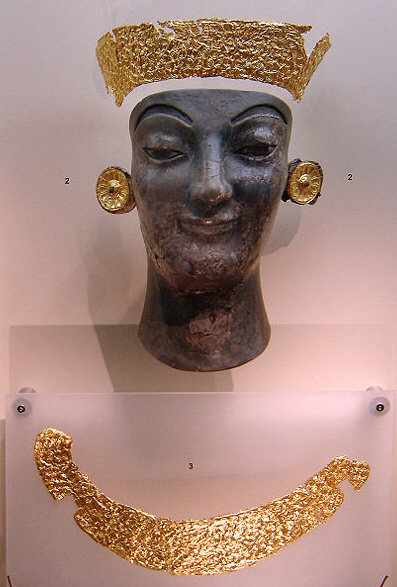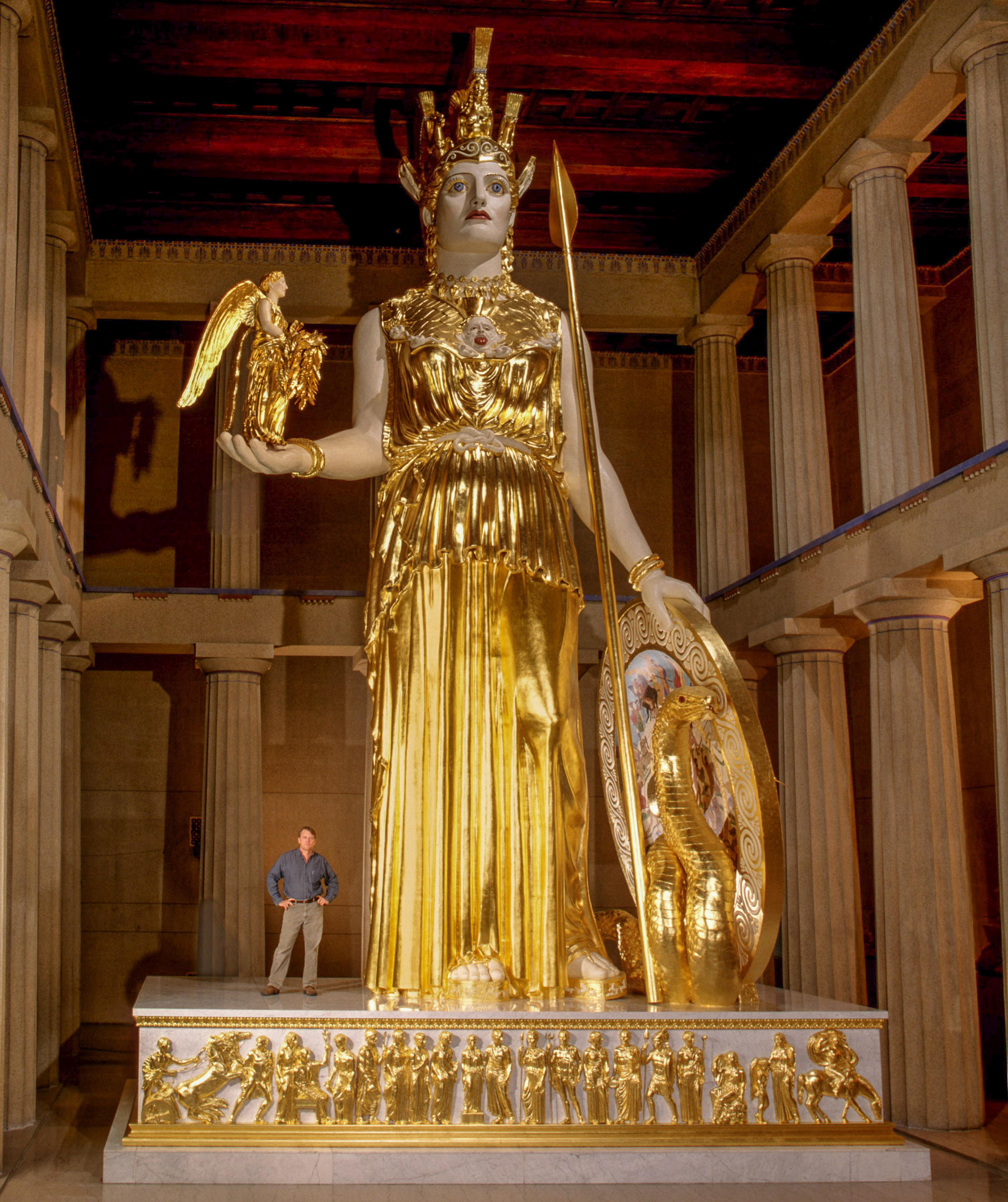Chryselephantine on:
[Wikipedia]
[Google]
[Amazon]
 Chryselephantine sculpture () is a sculpture made with
Chryselephantine sculpture () is a sculpture made with
 The two best-known examples, both from the Classical period, are those sculpted by
The two best-known examples, both from the Classical period, are those sculpted by
 The term ''chryselephantine'' is also used for a style of sculpture fairly common in 19th-century European art, especially
The term ''chryselephantine'' is also used for a style of sculpture fairly common in 19th-century European art, especially
 Chryselephantine sculpture () is a sculpture made with
Chryselephantine sculpture () is a sculpture made with gold
Gold is a chemical element; it has chemical symbol Au (from Latin ) and atomic number 79. In its pure form, it is a brightness, bright, slightly orange-yellow, dense, soft, malleable, and ductile metal. Chemically, gold is a transition metal ...
and ivory. Chryselephantine cult statues enjoyed high status in Ancient Greece
Ancient Greece () was a northeastern Mediterranean civilization, existing from the Greek Dark Ages of the 12th–9th centuries BC to the end of classical antiquity (), that comprised a loose collection of culturally and linguistically r ...
.
Ancient examples
Chryselephantine statues were built around a wooden frame with thin carved slabs of ivory attached, representing the flesh, and sheets of gold leaf representing the garments, armour, hair, and other details. In some cases, glass paste, glass, and precious and semi-precious stones were used for detail such as eyes, jewellery, and weaponry. The origins of the technique are obscure. There are known examples, from the 2nd millennium BC, of composite sculptures made of ivory and gold from areas that became part of the Greek world, most famously the so-called " Palaikastro Kouros" (not to be confused with the Archaic Kouros statues), from Minoan Palaikastro, BC. It is likely the only enshrined Minoancult image
In the practice of religion, a cult image is a Cultural artifact, human-made object that is venerated or worshipped for the deity, Spirit (supernatural entity), spirit or Daimon, daemon that it embodies or represents. In several traditions, incl ...
that has survived. It is, however, not clear whether the Greek chryselephantine tradition is connected with these.
Chryselephantine sculpture became widespread during the Archaic period. Later, acrolithitic statues, with marble heads and extremities and a wooden trunk either gilded or covered in drapery, were a comparable technique used for cult images.
The technique was normally used for cult statues within temples; typically, they were greater than life-sized. Construction was modular, so that some of the gold could be removed and melted for coin or bullion
Bullion is non-ferrous metal that has been refined to a high standard of elemental purity. The term is ordinarily applied to bulk metal used in the production of coins and especially to precious metals such as gold and silver. It comes from ...
in times of severe financial hardship, to be replaced later when finances had recovered. For example, the figure of Nike held in the right hand of Phidias
Phidias or Pheidias (; , ''Pheidias''; ) was an Ancient Greek sculptor, painter, and architect, active in the 5th century BC. His Statue of Zeus at Olympia was one of the Seven Wonders of the Ancient World. Phidias also designed the statues of ...
's Athena Parthenos
The statue of ''Athena Parthenos'' () was a monumental chryselephantine sculpture of the goddess Athena. Attributed to Phidias and dated to the mid-fifth century BCE, it was an offering from the city of Athens to Athena, its tutelary deity. The ...
was made from solid gold with this very purpose in mind. Indeed, in times of prosperity, up to six solid gold Nikae were cast, serving as a "sacred treasury" whose safety was ensured by the sanctity accorded to a cult object, as well as the presence of priestesses, priests, and maintenance staff at the temple.
 The two best-known examples, both from the Classical period, are those sculpted by
The two best-known examples, both from the Classical period, are those sculpted by Phidias
Phidias or Pheidias (; , ''Pheidias''; ) was an Ancient Greek sculptor, painter, and architect, active in the 5th century BC. His Statue of Zeus at Olympia was one of the Seven Wonders of the Ancient World. Phidias also designed the statues of ...
: the standing statue of Athena Parthenos in the Parthenon
The Parthenon (; ; ) is a former Ancient Greek temple, temple on the Acropolis of Athens, Athenian Acropolis, Greece, that was dedicated to the Greek gods, goddess Athena. Its decorative sculptures are considered some of the high points of c ...
at Athens
Athens ( ) is the Capital city, capital and List of cities and towns in Greece, largest city of Greece. A significant coastal urban area in the Mediterranean, Athens is also the capital of the Attica (region), Attica region and is the southe ...
, and the seated statue of Zeus
Zeus (, ) is the chief deity of the List of Greek deities, Greek pantheon. He is a sky father, sky and thunder god in ancient Greek religion and Greek mythology, mythology, who rules as king of the gods on Mount Olympus.
Zeus is the child ...
in the temple at Olympia, considered one of the Seven Wonders of the Ancient World.
Chryselephantine statues were not only intended to be visually striking; they also displayed the wealth and cultural achievements of those who constructed them or financed their construction. The creation of such a statue involved skills in sculpture, carpentry, jewellery, and ivory-carving. Once completed, the statues required constant maintenance. It is known that at Olympia, skilled personnel were employed to ensure the upkeep of the Zeus statue. In the second century BC, the prominent sculptor Damophon of Messene
Messene (Greek language, Greek: Μεσσήνη 𐀕𐀼𐀙 ''Messini''), officially Ancient Messene, is a local community within the regional unit (''perifereiaki enotita'') of Messenia in the region (''perifereia'') of Peloponnese (region), P ...
was commissioned to repair it.
Due to the high value of some of the materials used and the perishable nature of others, most chryselephantine statues were destroyed during antiquity and the Middle Ages. For example, of the statue of Athena Parthenos, only the hole that held its central wooden support survives today in the floor of her temple. The appearance of the statue is nevertheless known from a number of miniature marble copies discovered in Athens, as well as from a detailed description by Pausanias. Pausanias also described Phidias's statue of Zeus at Olympia. Here, some of the clay moulds for parts of Zeus's garments made of glass or glass-paste have been discovered in the building known as the "Workshop of Phidias". They are the only finds directly associated with the great sculptor's most famous works and thus provide useful information on their creation.
Few examples of chryselephantine sculpture have been found. The most prominent surviving examples are fragments of several smaller than life-sized burnt statues from the Archaic period, discovered at Delphi
Delphi (; ), in legend previously called Pytho (Πυθώ), was an ancient sacred precinct and the seat of Pythia, the major oracle who was consulted about important decisions throughout the ancient Classical antiquity, classical world. The A ...
. It is not known whom they depict, although they are assumed to represent deities.
Modern examples
 The term ''chryselephantine'' is also used for a style of sculpture fairly common in 19th-century European art, especially
The term ''chryselephantine'' is also used for a style of sculpture fairly common in 19th-century European art, especially Art Nouveau
Art Nouveau ( ; ; ), Jugendstil and Sezessionstil in German, is an international style of art, architecture, and applied art, especially the decorative arts. It was often inspired by natural forms such as the sinuous curves of plants and ...
. In this context, it describes statuettes with skin of ivory and clothing and other details made of other materials, such as gold
Gold is a chemical element; it has chemical symbol Au (from Latin ) and atomic number 79. In its pure form, it is a brightness, bright, slightly orange-yellow, dense, soft, malleable, and ductile metal. Chemically, gold is a transition metal ...
, bronze
Bronze is an alloy consisting primarily of copper, commonly with about 12–12.5% tin and often with the addition of other metals (including aluminium, manganese, nickel, or zinc) and sometimes non-metals (such as phosphorus) or metalloid ...
, marble
Marble is a metamorphic rock consisting of carbonate minerals (most commonly calcite (CaCO3) or Dolomite (mineral), dolomite (CaMg(CO3)2) that have recrystallized under the influence of heat and pressure. It has a crystalline texture, and is ty ...
, silver
Silver is a chemical element; it has Symbol (chemistry), symbol Ag () and atomic number 47. A soft, whitish-gray, lustrous transition metal, it exhibits the highest electrical conductivity, thermal conductivity, and reflectivity of any metal. ...
, or onyx. For instance, circa 1840 the sculptor Pierre-Charles Simart produced a copy in ivory and gold, based on ancient descriptions, of the Athena Parthenos
The statue of ''Athena Parthenos'' () was a monumental chryselephantine sculpture of the goddess Athena. Attributed to Phidias and dated to the mid-fifth century BCE, it was an offering from the city of Athens to Athena, its tutelary deity. The ...
of Phidias
Phidias or Pheidias (; , ''Pheidias''; ) was an Ancient Greek sculptor, painter, and architect, active in the 5th century BC. His Statue of Zeus at Olympia was one of the Seven Wonders of the Ancient World. Phidias also designed the statues of ...
for patron Honoré Théodoric d'Albert de Luynes. The result was somewhat disappointing: "... it cost Luynes a hundred thousand francs to prove that Simart was not Phidias." A 20th-century version of this figure by American sculptor Alan LeQuire stands in the modern reproduction of the Parthenon in Nashville, Tennessee
Nashville, often known as Music City, is the capital and List of municipalities in Tennessee, most populous city in the U.S. state of Tennessee. It is the county seat, seat of Davidson County, Tennessee, Davidson County in Middle Tennessee, locat ...
. After the 1890s, reflecting the change that Simart and some sculptors had already embraced, the meaning of ''chryselephantine'' was extended to include any statue fashioned in a combination of ivory with other materials.''Art Nouveau Sculpture'', Alastair Duncan.
In the early 20th century, German sculptors Ferdinand Preiss and Franz Iffland became well known for their chryselephantine sculptures. A number of other European sculptors also produced chryselephantine pieces, among them Joé Descomps, Josef Lorenzl, Georges Omerth, Claire J. R. Colinet, Pierre Le Faguays, D. H. Chiparus, Bruno Zach, and Dominique Alonzo.
See also
* Art in ancient Greece * Classical sculpture * Ram in a ThicketReferences
* {{DEFAULTSORT:Chryselephantine Sculpture Ancient Greek sculpture Ivory works of art Cult images